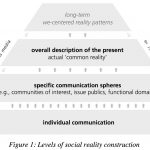30. Januar 2010
Frank Puscher hat einen unterhaltsamen Artikel zu der schönen neue und bessere Wirklichkeit geschrieben, die uns durch mobile Devices präsentiert wird. Kleine Kostprobe:
„Der tägliche Gang zur Bushaltestelle wird zur Reality Show: “Wussten Sie eigentlich, dass Friedrich Schiller genau in dieser Unterführung dereinst ein seidenes Taschentuch verlor?” Hätten Sie darüber nachgedacht, wären Sie möglicherweise der Auffassung gewesen, dass die in dieser Unterführung so filigran verarbeiteten Betonplatten erst in den 50er Jahren erfunden wurden. Aber Sie haben ja nicht nachgedacht. Sie haben gar nicht gedacht. Gut, dass es Augmented Reality gibt. Es ist keine angereicherte Wirklichkeit, es ist die bessere Wirklichkeit“.
Mehr hier!
30. Januar 2010
Millionen von Menschen eröffnen weltweit monatlich einen Twitter-Account und bescheren dem Dienst noch immer unglaubliche Wachstumsraten. Wie viele aber werden davon letztendlich regelmässig genutzt? The Metric System hat dazu eine neue Analyse veröffentlicht.
Der Studie zufolge entschieden sich im Juli 2009 fast acht Million Menschen dazu, einen Twitter-Account zu eröffnen. Im Dezember 2009 waren es hingegen schon rund 20 Prozent weniger.

Abgesehen von dieser immer noch beeindruckenden Kurve spricht laut der vorliegenden Studie aber auch einiges Weitere dafür, dass der grosse Hype vorbei ist: Über 50 Prozent der Accounts hatten Ende 2009 entweder gar keine oder weniger als fünf Follower. Lediglich ein Bruchteil der Accounts hatte mehr als 20 Anhänger, die wenigsten über 500. Ein beachtlicher Teil der Twitterer hat zudem noch nie ein Update gepostet, weit über ein Drittel kamen über neun Tweets nicht hinaus.
24. Januar 2010
Gartner Research Gartner hat schon Ende 2009 einen Vorschlag für die Top 10 der Mobile Consumer Applications für 2012 publiziert. Welche Kriterien hierfür angelegt wurden, wird aber leider nicht genauer definiert. Auffällig ist, dass diese Top 10 weder neu noch besonders überraschend erscheint und vielmehr Themen denn Applikationen angesprochen werden, zu denen es dato schon die verschiedensten Applikationen gibt. Gartner unterstreicht darüber hinaus, dass es primär um die Intensität der Nutzung im Markt geht und nicht um die schiere Anzahl der Anwendungen.
Hier die Gartner Top 10 für 2012:
- Money Transfer: This refers to people sending money via SMS messages. Like mobile payments, this service has more appeal in developing markets for now. However, there may come a time when even using your debit card seems passé, while paying for something with actual cash seems downright ancient.
- Location-Based Services: As mentioned above, there are still far too many services to choose from when it comes to location-based social networking, fragmenting the market. Your friends on Loopt are often different than those on Brightkite and that list is different than those on Foursquare. But LBS extends to more than social networks – it includes any application that taps into your phone’s GPS capabilities to offer up location-based services of any kind, whether that’s local business reviews or directions to the nearest Starbucks. Gartner says this will be one of the most disruptive technologies in the future, growing from 96 million in 2009 to 526 million in 2012.
- Mobile Search: No, mobile search isn’t new, but on the mobile platform, it may get shaken up a bit. Gartner predicts that consumers won’t necessarily be sticking with the search services they know and use on the Web (think Google, Bing, Yahoo) and instead experiment with using a few different search providers that have “unique technologies” for mobile search. While that statement is a little vague, it sounds like good news for services like Taptu who have entered this field with search offerings designed from the ground-up for mobile devices.
- Mobile Browsing: Saying that mobile browsing technologies will be heavily used in the future sounds a little bit like stating the obvious. But as Gartner notes, mobile browsing capabilities currently exist only on 60%+ of handsets today. By 2013, that number will climb to 80%, meaning that those who are still using the app-less,more basic feature phones will still be joining the mobile web in mass numbers over the coming years. That’s also good news for web developers who can build mobile web applications to cater to this bunch as opposed to focusing all their efforts into building apps for the numerous mobile platforms like the iPhone, Android, RIM, and others.
- Mobile Health Monitoring: Another technology whose impact will be felt more heavily in developing markets, mobile health monitoring is still at an early stage of maturity and implementation says Gartner. Project rollouts have been limited to pilot projects for now, but in the coming years the industry will begin to monetize these efforts by offering mobile healthcare monitoring products, services, and solutions to various care delivery organizations.
- Mobile Payments: Like mobile transfers, mobile payments are more common in developing markets at the moment, but that is quickly changing. Yet even as this type of service grows, Gartner admits there will be challenges. Mobile payments will be a “highly fragmented market” where there will not be “standard practices of deployment,” notes the report. That makes it sound like this is one technology that will still need some work, even when 2012 rolls around.
- Near Field Communications (NFC): More popular in some European and Asian markets than in the U.S., NFC still isn’t a standard feature on many of today’s phones. That may be about to change, too. In late 2010, Gartner says that NFC-enabled phones will begin to ship in volume, with Asia leading deployments, followed by Europe and North America.
- Mobile Advertising: Also not new but growing fast, mobile advertising is one of the most important ways to monetize mobile content. Total spending on mobile advertising in 2008 was $530.2 million and it will grow to $7.5 billion in 2012. And mobile advertising will also be used by companies alongside their other campaigns including TV, radio, print, and outdoors.
- Mobile Instant Messaging: Gartner says that latent user demand and market conditions are conductive to mobile IM’s future adoption. It will appeal to developing markets where mobile phones are often the only connectivity device a user owns. But will it be a major app by 2012? It seems that SMS is still the service to beat, especially in the developing world. We’ll have to wait and see on this one.
- Mobile Music: Sure, you have the iPhone, but what about your other options? What about mobile music services – especially those for non-iPhone devices? We’re still waiting on Spotify in the U.S., for example, and their competition too. Gartner says that we’re beginning to see new innovative models in this area that will include both device (think “Comes with Music”) and service bundles.















